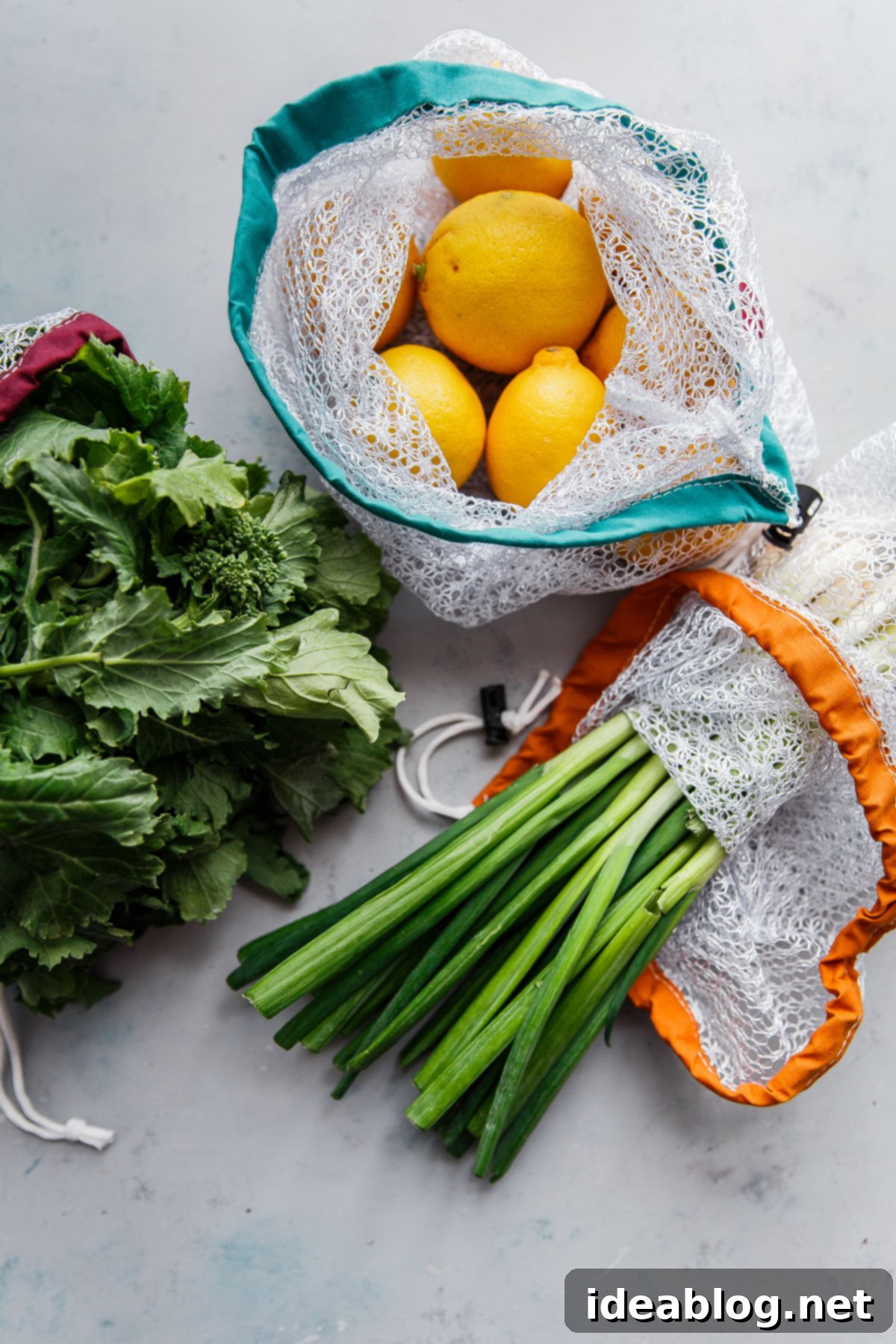Sustainable Kitchen Habits: Practical Tips to Drastically Reduce Your Waste
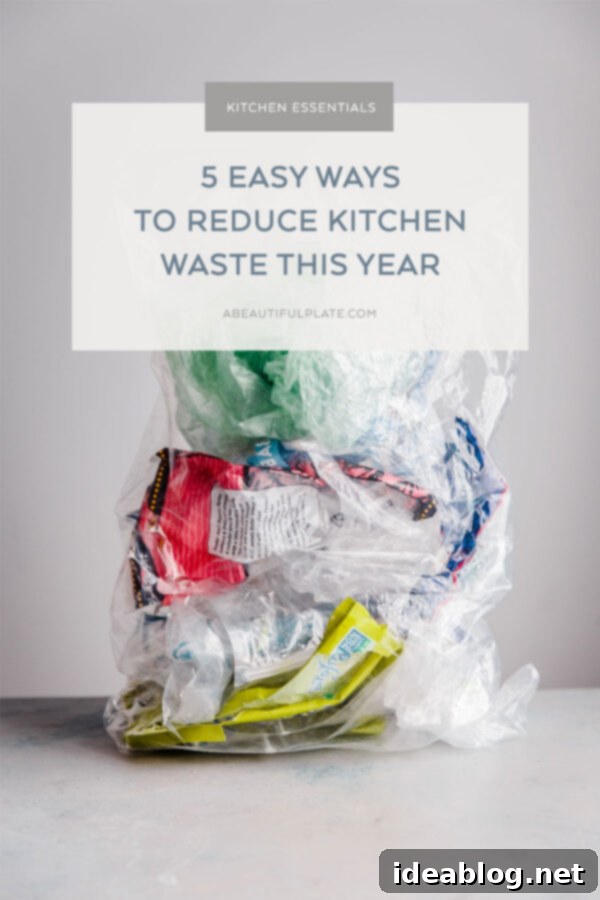
I am thrilled to share today’s post with you! The topic of reducing kitchen waste has been a significant focus for me over the past year. This is particularly true given the demands of my work, which involves extensive recipe testing, frequent grocery shopping, and numerous product shipments – all activities that inherently generate waste. My personal journey towards a more sustainable kitchen has been incredibly insightful, and I’m eager to share what I’ve learned.
Before diving in, I want to clarify that my aim is not to preach or advocate for a rigid, zero-waste lifestyle. I don’t personally adhere to one, and frankly, striving for absolute perfection in any aspect of life can be overwhelming, impossible, and often leads to inaction. This holds especially true, in my experience, when it comes to the complex area of kitchen waste. Our goal should be progress, not perfection.
While acknowledging that reducing waste is incredibly important and often necessitates a shift in mindset, it’s crucial to understand that even the smallest, most manageable changes can collectively have enormous impacts. These incremental efforts are the building blocks that gradually form long-standing habits and foster genuine lifestyle transformations. Each conscious choice, no matter how minor, contributes to a healthier planet and a more sustainable future.
For some individuals, a simple starting point might be investing in a reusable travel mug for their daily coffee shop visits or carrying a reusable water bottle for hydration on the go. For others, it could involve consistently choosing reusable containers and packaging instead of single-use plastic wrap or disposable bags just a few extra times each month. The path to reducing waste is deeply personal and will undoubtedly look different for everyone, tailored to their unique circumstances and priorities.
My primary goal with this post is to offer practical resources, actionable tips, and accessible methods that I’ve successfully integrated into my own routine to minimize kitchen waste over the past year. I sincerely hope that you find these insights both useful and inspiring, empowering you to embark on your own journey towards a more eco-friendly kitchen.
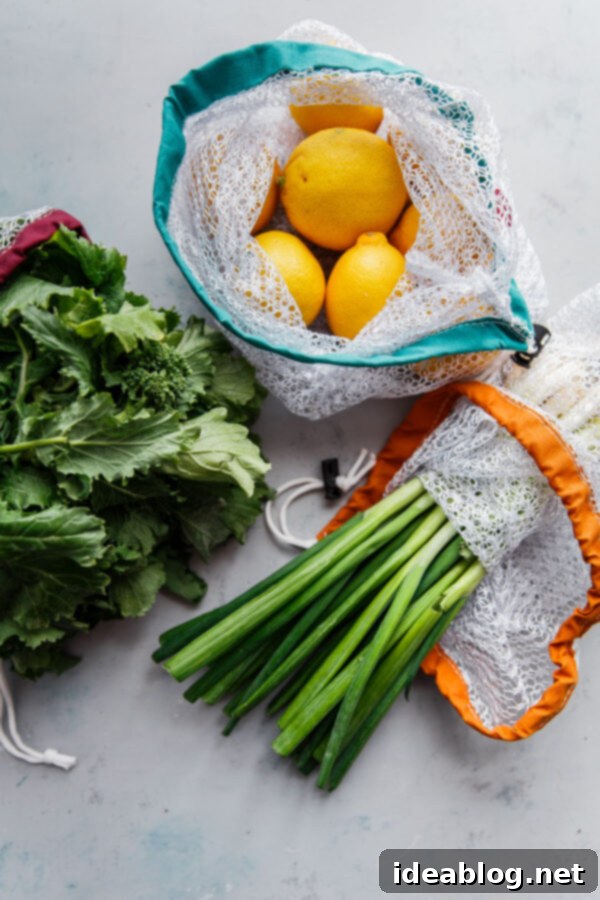
This post contains affiliate links. If you purchase an item below, I may receive a small commission at no cost to you.
Embrace Reusable Produce and Grocery Bags for Sustainable Shopping
The transition to reusable grocery bags has been a part of my routine for many years now. Despite their widespread availability and undeniable benefits, I’m consistently surprised by the number of people, particularly in urban environments, who arrive at the checkout line without them. While I admit there are still occasions when I forget mine, embracing reusable bags is genuinely one of the simplest yet most impactful changes you can integrate into your shopping habits.
Reusable grocery bags are incredibly practical and offer numerous advantages over their single-use plastic counterparts. They typically boast significantly greater carrying capacity, allowing you to transport more items per trip. Many designs feature comfortable shoulder straps, making heavy loads easier to manage, and – crucially – they eliminate the risk of bags breaking and spilling your groceries. Beyond shopping, these versatile bags also prove invaluable for moving household items, tackling various chores, or even packing for a trip.
In the last year, I’ve taken my commitment a step further by investing in a set of reusable produce bags. These mesh or cloth bags are another fantastic tool for significantly reducing your reliance on flimsy, single-use plastic bags for fruits and vegetables. It’s worth noting that while they are excellent for transporting produce, they don’t always keep delicate items fresh for extended periods once you’re home. For optimal freshness, it’s best to wash, prep, and store these delicate items in appropriate containers after unpacking your groceries.
Helpful Tip for Remembering Your Bags: The key to consistently using reusable bags is strategic placement. Keep a small set wherever you are most likely to need them:
- In your car trunk or passenger seat.
- Near your front door or in the pantry/hallway.
- Stashed in your office bag, workout bag, or purse.
I personally prefer the super thick, sturdy reusable bags often found at stores like Trader Joe’s and Whole Foods, as their durability allows them to hold a substantial amount of groceries. However, there are many excellent thinner, foldable options available that are perfect for stashing away. Ultimately, the best choice depends on your personal preference and lifestyle!
Navigate Soft Plastic Recycling for a Greener Home
One of the most substantial leaps I’ve made in reducing my kitchen waste this past year stems from educating myself on soft plastics and their proper disposal. A little bit of research truly goes a long way in making a big difference. If you’re ever unsure about how to recycle a particular item, or even if it’s recyclable at all, don’t hesitate to do a quick online search, contact your local recycling service provider, or reach out directly to your favorite brands for clarification.
Basic plastics, such as rigid food containers, milk jugs, and other hard plastic cartons, are typically processed through your standard weekly curbside recycling service. However, it’s absolutely critical to always verify the specific recycling rules and regulations in your local municipality, as they can vary significantly from one area to another.
Recyclable soft plastics, also known as plastic film, encompass a wide array of everyday items. This category includes common household plastics like garbage bags, the plastic coverings for newspapers, product wrapping (such as that around paper towels or toilet paper), shopping bags, dry cleaning bags, bubble wrap, deflated air pillow packaging from deliveries, and even reusable Ziploc-style bags once they are no longer usable. It’s vital to understand that these types of plastics require a completely different processing method than hard plastic items. If soft plastics are placed in standard recycling bins, they tend to clog machinery, disrupt the sorting process, and can easily contaminate large batches of otherwise recyclable materials, ultimately leading to those batches being diverted directly to landfills. You can gain further insight into this issue and identify other items you might be recycling incorrectly by reading articles such as this one. Knowledge is power, and sharing this information with those around you can create a ripple effect of positive change.
Fortunately, many large retail stores (e.g., major grocery chains, Target, Walgreens, etc.) are often required to provide designated soft plastic recycling drop-off containers. These easily accessible locations make it convenient to recycle plastic film properly. You can quickly find your nearest plastic film recycling location by using online tools like the one provided here. In our household, we collect all our soft plastic items in a dedicated reusable grocery bag and make a monthly trip to our local Target to drop them off. This simple routine has drastically reduced the amount of plastic waste we send to landfills, making a tangible difference.
Helpful Tips and Resources for Soft Plastic Recycling:
- To deepen your understanding of what constitutes recyclable plastic film and what doesn’t, explore detailed guides available here. This resource can help you make informed decisions.
- Establish a simple system at home: designate a large bag in a closet or pantry specifically for collecting soft plastic items. As you accumulate them, place them in this bag. Then, on a bi-weekly, monthly, or bi-monthly schedule, take the filled bag to your nearest soft plastic recycling drop-off location. You can easily find these locations via resources like PlasticFilmRecycling.org. A critical reminder: all items must be dry and unsoiled. Often, a quick rinse under the sink followed by air-drying is all that’s needed to prepare them for recycling.
- TerraCycle is another incredible organization that offers innovative recycling solutions. They provide many free recycling options through partnerships with popular household brands (e.g., Colgate, Clif), allowing you to recycle specific product packaging that isn’t typically accepted curbside. Additionally, TerraCycle offers various paid recycling programs for an extensive range of items, including silicone products, baby food pouches, snack bar packaging, clothing, and kitchen tools – virtually anything you can imagine that traditionally ends up in a landfill.
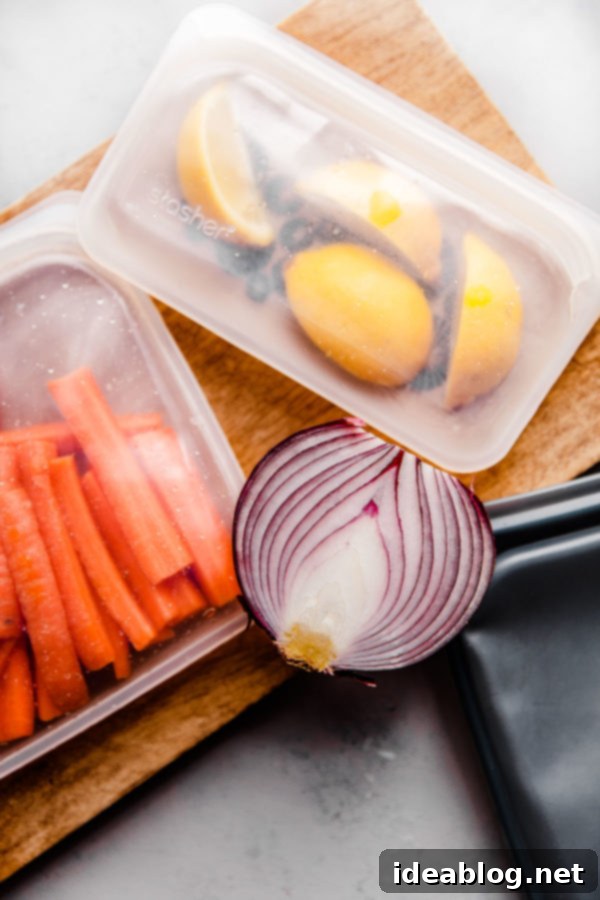
Invest in Reusable Silicone Bags and Containers for Smart Storage
While I’ve been a long-time user of durable glass storage containers for food, I’ll be the first to admit that the sheer convenience of grabbing an easy, disposable Ziploc bag for marinades, meal prep, or general food storage can be incredibly tempting on busy days. This highlights a pervasive theme when it comes to kitchen waste: convenience often comes at the cost of sustainability.
The allure of convenience is powerful and ever-present. I completely understand its appeal. However, reducing kitchen waste in our modern society undeniably requires a conscious effort and a willingness to sometimes sacrifice immediate convenience for long-term environmental benefits. We all have a role to play in this global effort, especially those of us who are in a privileged position to make these sustainable choices.
The good news is that making small, regular changes doesn’t have to be daunting. The trick is to start slow and gradually build up your sustainable habits. A specific goal I set for myself last year was to invest in a few high-quality reusable silicone bags, like Stasher bags, in various sizes. This simple investment has dramatically reduced my reliance on single-use plastic bags. We now use these versatile silicone bags for a multitude of purposes: they are perfect for travel snacks, storing a wide range of foods (such as sandwiches, cut vegetables, cheese, and avocados), and are even excellent for meal prep, like marinating meat for the grill.
If you do find yourself needing to use a traditional Ziploc-style bag, remember that they are often more durable than you think. They can frequently be washed, thoroughly dried, and reused multiple times, especially if you’ve only used them for relatively clean items like bread, nuts, or produce. Once they eventually become unusable or worn out, they can then be recycled along with your other soft plastic items (refer to the previous section for details on soft plastic recycling).
Helpful Hint for Affordable Storage: You don’t need to break the bank by investing in a large, expensive set of brand-new containers or bags to effectively reduce kitchen waste. Many sustainable options are already within your reach or can be acquired affordably. Repurpose glass food jars (from sauces, jams, etc.), buy inexpensive mason jars for dry goods or liquids, or simply utilize covered mixing bowls and other dishes you already own for fridge storage. Creativity and resourcefulness are key to an eco-friendly kitchen!

Embrace Bee’s Wrap as a Biodegradable Alternative to Plastic Wrap
Among my favorite sustainable kitchen innovations is natural Bee’s Wrap! This remarkable product offers a fantastic and far superior biodegradable alternative to conventional plastic wrap, which is notoriously difficult to recycle and contributes significantly to landfill waste. Bee’s Wrap is ingeniously crafted from organic cotton fabric that has been infused with melted beeswax, creating a pliable and naturally antimicrobial food covering. I first discovered this brilliant brand a few years ago when my mom gifted me a pack, and I’ve been an enthusiastic advocate ever since.
You can purchase Bee’s Wrap in convenient sets containing various sizes, or you can opt for specific sizes based on your most frequent needs. These wraps perform exceptionally well for covering, wrapping, and storing almost any food item, with the notable exception of raw meat. The magic lies in their ability to conform precisely to the shape of your item or bowl using just the warmth and pressure of your hands. We integrate them into our daily kitchen routine for everything from extending the freshness of stored bread, keeping cheese fresh, covering leftover bowls, to wrapping cut fruits and vegetables.
Perhaps the best feature of Bee’s Wrap is its reusability and longevity. After each use, they can be easily hand-washed under cold water with a mild soap, then air-dried, and are ready to be used again. With proper care, a single set can last for up to a year or even longer! Having a collection of these on hand, paired with a few reusable storage bags or containers, will drastically reduce, if not entirely eliminate, your reliance on disposable plastic wrap.
Another effective strategy to eliminate plastic wrap from your kitchen is surprisingly simple: stop buying it altogether. The principle of “out of sight, out of mind” truly applies here. One of the biggest obstacles to reducing kitchen waste often comes down to sheer convenience – simply having the option readily available at your fingertips. Once you no longer have plastic wrap in your pantry, and you’ve established alternative sustainable options, you’ll naturally stop thinking about it and reach for your eco-friendly solutions instead.
Helpful Hint for Quality: While some retailers, like Trader Joe’s, sell generic versions of beeswax wraps, I’ve personally tested them and found them to be excessively thick, which hinders their effectiveness and ease of use. I highly recommend investing in the original Bee’s Wrap brand; their product is consistently thinner, more pliable, and performs significantly better. If you’re feeling particularly ambitious and enjoy DIY projects, you can even find recipes and tutorials to make your own beeswax wraps at home!
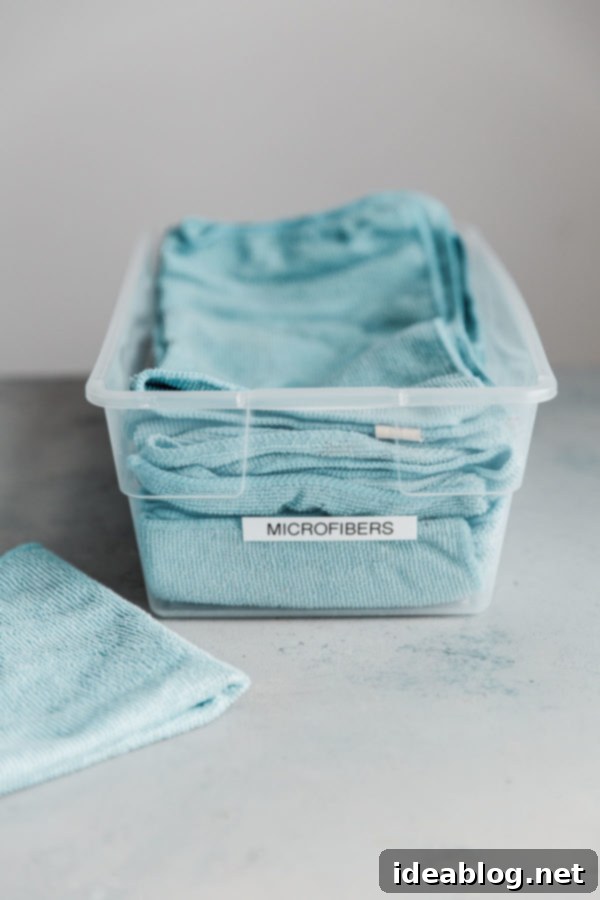
Replace Disposable Paper Towels with Reusable Cloths
Over the past two years, one of the most significant and satisfying changes I’ve made to my kitchen routine is the near-complete elimination of paper towel use. This transformation was achieved by simply investing in a durable set of basic microfiber cloths. This is an incredibly straightforward and effective way to dramatically reduce kitchen waste, and an added bonus is the substantial amount of money you’ll save on paper towel purchases over time!
We now rely on these versatile cloths for a multitude of cleaning tasks around the kitchen: wiping down countertops, polishing appliances, quickly cleaning up spills on the floor, and general tidying. For ultimate convenience, we keep a container filled with clean cloths readily accessible under the kitchen sink. Unlike paper towels, which are single-use, these cloths can be easily rinsed out after minor spills and then laundered for repeated use, making them a far more sustainable option.
While I do keep a roll or two of paper towels on hand, they are reserved for rare, particularly messy or unsanitary household tasks, such as cleaning up pet accidents or truly disgusting spills that I wouldn’t want to put in the laundry. I find myself reaching for them almost never. The key to making this transition seamless is to acquire a sufficiently large set of cloths – ideally between 18 to 24. This ensures that you always have a fresh supply available, even between laundry loads. We typically designate some cloths specifically for kitchen cleaning and others for bathroom or general household cleaning, maintaining a clear separation for hygiene.
Helpful Tip for Cloth Care: Microfiber cloths can sometimes develop static cling during laundry cycles, so keep this in mind when sorting your loads. If your cloths ever start to develop an “off” or musty smell, a simple solution is to add a quarter cup of baking soda or a half cup of basic white vinegar to your washing load. This natural deodorizer almost always eliminates unpleasant odors, leaving your cloths fresh and ready for use.
Other Significant Ways to Further Reduce Your Kitchen Waste:
- Explore Home or Local Composting Options and Pick-Up Services: Composting is arguably one of the most impactful actions you can take to reduce kitchen waste. A staggering majority of household trash consists of compostable items, including food scraps, vegetable peels, coffee grounds, eggshells, and other organic fibers. By diverting these materials from landfills, you not only reduce waste but also contribute to enriching soil and minimizing methane gas emissions from decomposition. Even if you don’t have outdoor space for a traditional compost bin, many cities now offer convenient pick-up compost alternatives or community drop-off sites. I am actively researching and planning to invest in a composting service this year and will certainly share my experiences and findings with you all!
- Master Meal Planning and Food Waste Reduction: A significant portion of kitchen waste comes from uneaten food. By strategically planning your meals, creating detailed grocery lists, and buying only what you need, you can dramatically reduce food waste. Learn to properly store produce to extend its shelf life, and get creative with leftovers and “ugly” produce.
- Buy in Bulk and Reduce Packaging: Whenever possible, purchase items like grains, nuts, seeds, pasta, and spices from bulk bins using your own reusable containers or bags. This cuts down on unnecessary packaging and often saves money. Seek out local shops that offer refill stations for liquids like olive oil, soap, or vinegar.
- Repurpose and Upcycle: Before discarding items, consider if they can be repurposed. Glass jars can become storage containers, old t-shirts can be cut into cleaning rags, and plastic containers can be reused for various household organization needs.
